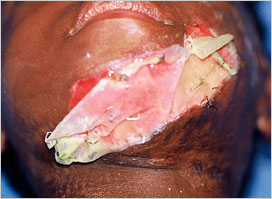| Premature Silicone
Separation POD 1-21 |
|


The silicone layer can be left in place
for extended periods without detrimental affects to the
underlying wound. Premature separation of the silicone
is not a problem if it stays in contact with the healing
wound.
Early Silicone Separation POD 1-9
- Inspect wound for signs of shearing,
fluid collection, hematoma, or infection. Detect loose
areas
of INTEGRA™ Bilayer Matrix
Wound Dressing by using your finger to slide
loose silicone.

- Remove the source of the separation
and re-attach

- If the INTEGRA™
Bilayer Matrix Wound Dressing takes, then cover
the exposed tissue with temporary covers, or epidermal
autograft to prevent desiccation
Late Silicone Separation POD 10 or higher
- Remove source of non-adherence. Remove
silicone if unable to re-secure.

- If INTEGRA™
Bilayer Matrix Wound Dressing does not take,
remove and replace with new INTEGRA™
Bilayer Matrix Wound Dressing and/or other suitable
material

- If INTEGRA™
Bilayer Matrix Wound Dressing takes, then cover
the exposed tissue with temporary covers, or epidermal
autograft to prevent desiccation